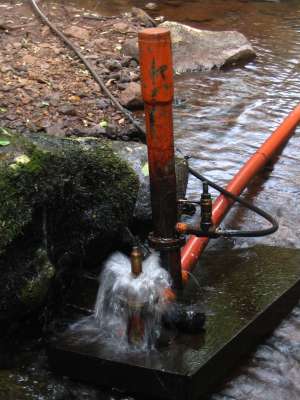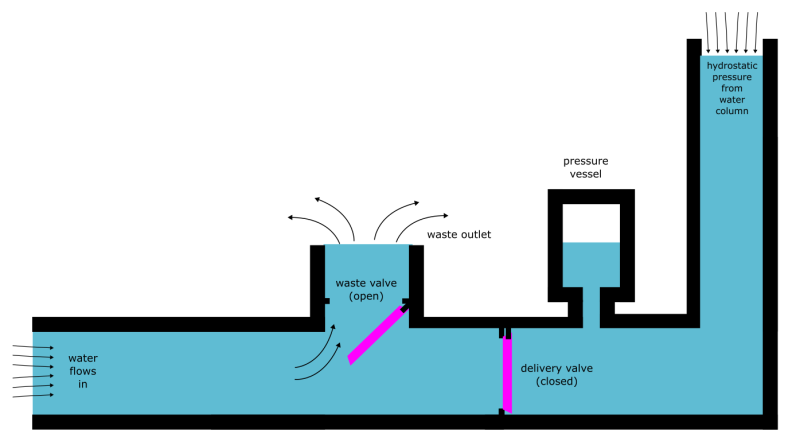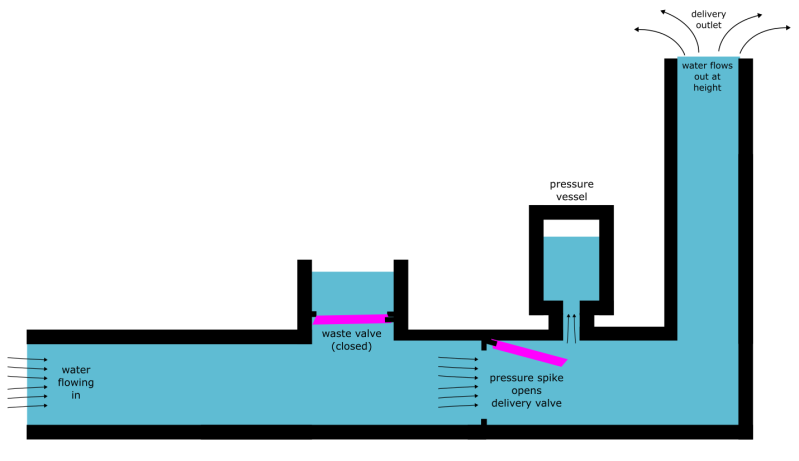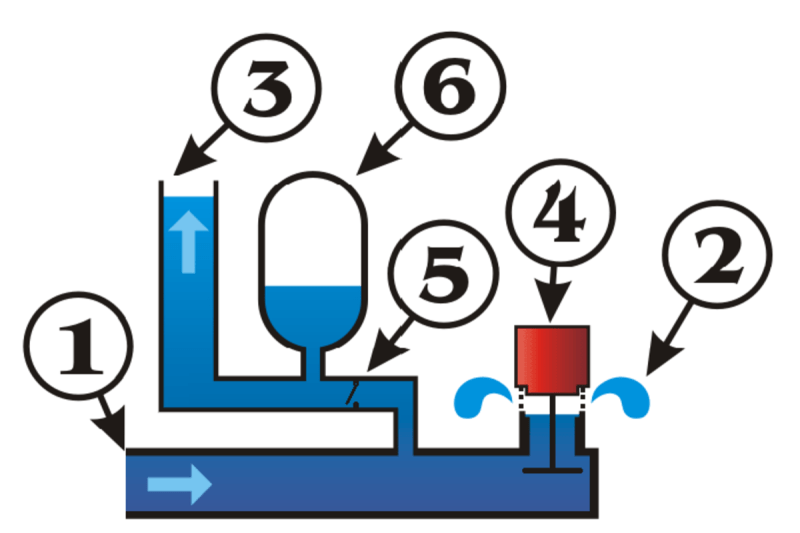Imagine you have a natural stream running through a low-lying area on your farm. It’s a great source of fresh water, only you really need it to irrigate some crops sitting at a higher elevation. The area is quite remote from fixed utilities, complicating the problem.
Your first thought might be to grab a commercial off-the-shelf pump of some sort, along with a fancy solar power system to provide the necessary power to run it. But what if there were a type of pump that could do the job with no external power input at all? Enter the hydraulic ram pump.
The hydraulic ram pump stands as one of the most elegant examples of appropriate technology, converting the kinetic energy of flowing water into enough pressure to lift a portion of that water to heights that seem to defy gravity. This ingenious device requires no external power source and very little maintenance, making it a perfect solution for pumping applications in remote areas where it’s otherwise inconvenient to supply a pump with electricity or fuel.

At its heart, the hydraulic ram pump exploits a phenomenon known as water hammer, the same effect that causes your pipes to bang when you quickly shut off a faucet. When flowing water is suddenly stopped, its momentum creates a pressure wave. When it comes to your pipes, you hear this rattling, hammering sound that is mostly just annoying. However, that pressure spike can actually instead be harnessed to do useful work—like pushing water uphill. It just requires some smart valving to do so.
The pump consists of just a few key components: a drive pipe that channels water from a source, a waste valve that normally allows water to flow freely, a delivery valve leading to the pump’s output, and an air chamber that acts as a pressure accumulator. These parts work together to create a self-sustaining pumping action.
The operation of the pump begins with water flowing down the drive pipe from a source that sits higher than the pump, such as the flow from a river or stream. Initially, the waste valve is open and water flows freely through it. As the flow velocity increases, the waste valve begins to rise due to the drag of the water flowing through it. Eventually, the valve rises to the point where it is completely shut, suddenly stopping the flow of water. This sudden halt causes water hammer, where the kinetic energy of the flowing water is converted into a powerful pressure spike that forces the delivery valve open, pushing water up through the pump outlet. Eventually, the pressure drop following the water hammer event causes the waste valve to reopen and the delivery valve to close, allowing the cycle to begin anew.


Some pumps add a pressure chamber to the system, where the pressure spike leads to a vessel, compressing the air trapped inside. The compressed air acts like a spring, maintaining outflow pressure even after the initial water hammer effect subsides. This can improve flow and reduce strain on components of the pump by evening out the sharp pressure spikes when the waste valve closes.
This being Hackaday, we should mention that this is a lot like a step-up DC-DC converter, with an inductor playing the role of the water-filled pipe, providing intertia, and a diode and a smoothing capacitor playing the parts of the check value and air vessel. In electrical step-ups, the waste valve is usually a MOSFET to ground, and its driven electronically, rather than being slammed shut by the water hammer.
A hydraulic ram pump effectively takes a rapid flow of water at low pressure and delivers a low-speed flow at high pressure, allowing water to be readily delivered to a tank or output at higher elevation than the source. The ratio between the vertical fall of the drive water and the height to which water is lifted determines the amount of water reaching the output. For example, if the water source is 1 meter above the ram pump itself, and the delivery pipe is 10 meters above the pump, just 10% of the water will be delivered to the output with the other 90% passing out through the waste valve. Ultimately, though, this is generally considered an acceptable trade-off for a pump running from a natural water course with no external power input, with the waste valve outflow simply returning to the river or stream the pump is installed in. A hydraulic ram pump can be left running for a great deal of time to deliver more water and irrigate an area or fill a tank, even if the instantaneous flow rate is low. After all, you’re not paying for any power to run it!
Hydraulic ram pumps are popular where it’s desirable to pump water to some greater height without the need for an external power source.
Today’s hydraulic ram pumps find applications ranging from rural water supply systems to irrigation projects in developing countries. The hydraulic ram pump can prove useful in most any situation where it’s desirable to pump water to high elevation with no external power input. Ultimately, the hydraulic ram pump represents sustainable technology at its finest. It’s a clean, undisruptive way to harness natural energy to do useful work. What’s more rewarding than that?
Featured image: “Hydraulic Ram” by [Gutza] and [Sonett72].
















we have a water ram lik this here in the Sonsbeekpark in Armhem. it feeds a fountain, albeit the smoothing is omitted, so the fountain pulses. the feed height difference is not that much. about 2 meters. but is works quite well when its turned on. it us quite loud though.
There was a farm near my inlaws that had a hydraulic ram in a creek next to the road. I’d see it every timer I’d go for a walk. It was pretty interesting to watch.
Same principle, but different: turning off a water storage power station and then this happens in the surge tank…
https://www.youtube.com/watch?v=fJVBlhgt9j8
This is the exact same principle of an ignition coil in a car with a classic ignition system. You’re trading volume for pressure. (wattage for voltage)
Today I learned that as a kid, I tried really hard to “fix” a farmer’s ram pump because it was “leaking really bad” and I didn’t know better. Sorr,y old farmer bro!
I lived in Kentucky USA as a child and alot of farms used hydraulic rams to fill their stock tanks. The inlet would be placed in a flowing creek and the outlet would be significantly higher and it would pump a pencil sized stream nonstop. The actual antique ones are very cool looking. https://mcquinnpumps.co.nz/pump/hydraulic-ram-pump-no-5/
I think the closest analog would be a Joule thief?
I thought this felt familiar, so I went digging. Sure enough, it was covered in a hack a few years back. I remember learning more about it at the time, as the concept was pretty interesting.
https://hackaday.com/2017/06/07/diy-ram-pump-obeys-the-laws-of-physics/
is it possible to build this without moving parts, such as by using a tesla valve as replacements.
no
a tesla valve wouldnt work in this application. They act as a one way flow restrictor. You wouldnt get the pressure build up/release cycle without a proper valve.
A pulser pump does a similar job without moving parts. It has uses a trompe to build up air pressure and uses that air pressure to lift the water to a higher elevation.
As a woman who loves technology I love reading how humans overcome challenges using their mind and configuring what if answers.
“As a HUMAN woman (who is totally not an AI chatbot) that loves technology I love reading how other also human beings (who are also totally not chatbots) overcome challenges using their mind and configuring what if answers.”
As a totally human person who interacts with physical objects using a current anthropomorphic modality, I too also interpret an implied weight of interest in the depiction of humans (living or otherwise),
– comparing
– composing
– developing
– deriving
– researching
developments in theoretical spaces.
Not sure if I agree with ‘no external power’. The pump needs a considerable amount of energy from the creek’s waterflow. Is that ‘external’? It’s for sure not free energy as in a perpetuum mobile.
the statement is clearly meant to reflect that the pump doesnt require electricity nor fuel to operate. scavenging gravitational energy from the water.
If today we say “no external power” we most certainly mean no electricity or burning fuel. That the system needs some energy to work should be clear for everyone.
Same with a wind tower, generate wind flow with no external power needed, just exploiting pressure differences.
I don’t think this is curmudgeonly. A less sensationalist title might be “waterpower pump works without electricity”, which doesn’t makes it sound like perpetual motion. “External” and “electrical” are different ideas.
There’s use a difference in precise language and that used for ready to read articles. The biggest is the use of colloquial assumptions.
It is curmudgeonly, we know what is being discussed.
Not only that, but saying “without electricity” would be overly limited in this case. (As it also doesn’t use fuel, wind, or heat to achieve this.)
It harvests energy from the water source itself to power the pumping action. So saying “no external power input” is pretty accurate.
I suppose you could argue that gravity is an external power input… but that feels disingenuous.
I would hope that the supposedly scientifically literate audience of a technology-centric website would not need to have it spoon-fed to them that this device does not violate the laws of physics.
1792 french Montgolfier pump.
Yes, there are many examples, it’s useful to provide more than a name though.
Watching these work is a great way to understand the operation of a classic boost converter.
I love these deceivingly simple solutions of yore that are still as effective and useful as they were when invented. Very few would be able to derive such an elegant solution to such problems utilizing only a few basic principles. I think it also takes some maturity and perspective to admire these.
Never heard of hydraulic ram pumps before but these serve a great example, thank you HaD for that.
A personal favorite of mine is the thermosiphon water heater – you may want to make a short writeup on that one as its one of these elegant solutions.
Great topic. The people that thought of this so many years ago were real problem solvers… I like the little add on discussion about the inductor !! Harvesting a bit of energy incracramently, all over the place, is the way to go… thanks for the note!
It’s “mostly just annoying” unless you don’t turn the faucet ALL the way off. If you turn the tap ALMOST off – and do it fast enough – you may experience water hammer that just keeps going. I’m pretty sure that will eventually cause some damage, but when I experienced it I quickly turned the flow back up and then turned the valve off more slowly. (I now realize that I could have just continued turning it all the way off).
When this happened to me decades ago, it wasn’t a fluke – I could repeat it at will. I didn’t do that more than a couple of times though – the noise was really loud and as a kid I found it kinda scary.
I can imagine that a bunch of factors came together in just the right combination – maybe the length of the pipe, how well it was secured, the amount of play in the valve stem, the wear on the washer, and probably other things I haven’t thought of.
Is it better/equal to a Wirz pump?
Struggling to find stats on either (that are useful for comparison..)
wirz pumps are limited to applications where the required lift is below 74 feet.
A hydraulic ram pump can lift water up to 600 feet above the source.
Thanks!
I would say that would be super application specific, I have to say 70 feet seems plenty? I also light the simplicity of the Wirz, plonk them in the stream, the only moving part is an axle and the rotating connection.
70 feet is plenty if you only need to lift the water 70 feet.
A wirz pump would be useless for us.
Before my great grandfather developed the springhead in the 50s, Our family homestead’s water was pumped by a hydraulic ram pump from the stream that runs along the bottom of the property ~350 feet below our storage tanks. When he decommissioned the old rampump he setup a pelton wheel power plant on the stream. Its powered the homestead, and our electric water pump ever since.
Holy crap, I would LOVE to be able to live on a plot that has a 100m change in altitude!
I guess this is my point. Some places this would be super useful, others, no so much. Use what works for your situation (is the message I am taking home!)
@grant yardley
In total we have closer to 200m in total vertical change.
Its a beautiful piece of land but there are drawbacks to it as well. We have very little flatland. Weve spent a lot of time, effort, and money over the years carving building sites into the hillside to preserve what natural flatland there is for livestock grazing.